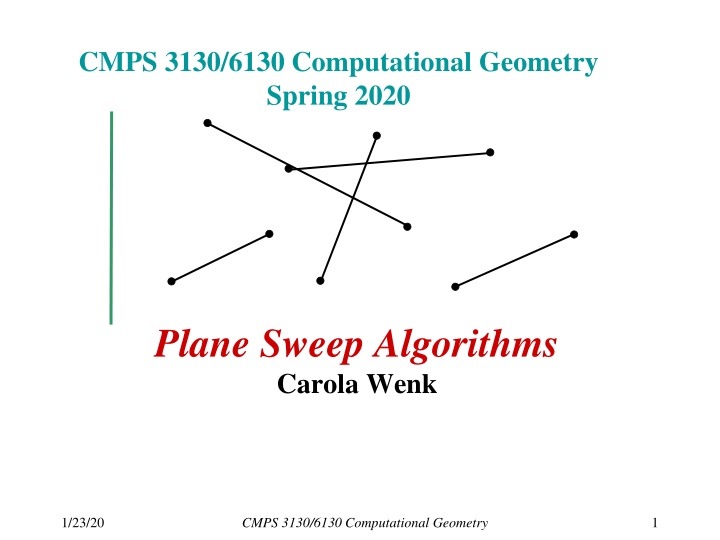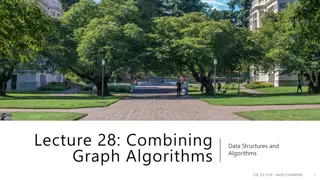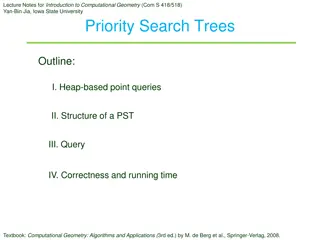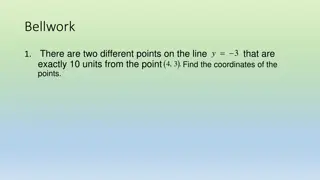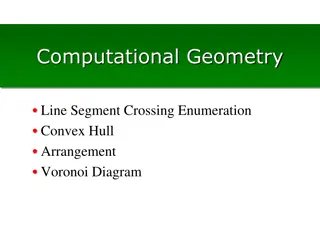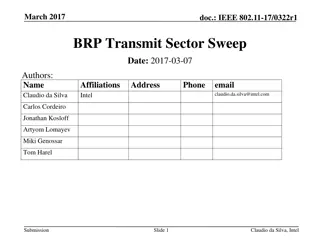Plane Sweep Algorithms in Computational Geometry
Plane sweep algorithms are a powerful technique in computational geometry for solving various problems efficiently. By simulating the sweep of a vertical line across the plane and maintaining a cleanliness property, these algorithms can process events at discrete points in time to update the status along the sweep line. The closest pair problem is a classic example that can be solved using a plane sweep approach, achieving a time complexity of O(n log n). By presorting points and storing them in a balanced binary search tree, the algorithm efficiently computes the closest pair distance within the given set.
Download Presentation

Please find below an Image/Link to download the presentation.
The content on the website is provided AS IS for your information and personal use only. It may not be sold, licensed, or shared on other websites without obtaining consent from the author.If you encounter any issues during the download, it is possible that the publisher has removed the file from their server.
You are allowed to download the files provided on this website for personal or commercial use, subject to the condition that they are used lawfully. All files are the property of their respective owners.
The content on the website is provided AS IS for your information and personal use only. It may not be sold, licensed, or shared on other websites without obtaining consent from the author.
E N D
Presentation Transcript
CMPS 3130/6130 Computational Geometry Spring 2020 Plane Sweep Algorithms Carola Wenk 1/23/20 1 CMPS 3130/6130 Computational Geometry
Closest Pair Problem: Given P R2, |P|=n, find the distance between the closest pair in P Na ve algorithm: Check all pairs of points in time O(n2) 1/23/20 2 CMPS 3130/6130 Computational Geometry
Plane Sweep: An Algorithm Design Technique Simulate sweeping a vertical line from left to right across the plane. Maintain cleanliness property: At any point in time, to the left of the sweep line everything is clean, i.e., properly processed. Sweep line status: Store information along the sweep line Events: Discrete points in time when the sweep line status needs to be updated 1/23/20 3 CMPS 3130/6130 Computational Geometry
Plane Sweep: An Algorithm Design Technique Simulate sweeping a vertical line from left to right across the plane. Maintain cleanliness property: At any point in time, to the left of the sweep line everything is clean, i.e., properly processed. Sweep line status: Store information along the sweep line Events: Discrete points in time when the sweep line status needs to be updated Algorithm Generic_Plane_Sweep: Initialize sweep line statusS at time x=- Store initial events in event queue Q, a priority queue ordered by x-coordinate while Q // extract next event e: e = Q.extractMin(); // handle event: Update sweep line status Discover new upcoming events and insert them into Q 1/23/20 4 CMPS 3130/6130 Computational Geometry
Plane Sweep for Closest Pair Problem: Given P R2, |P|=n, find the distance of the closest pair in P Sweep line status: Store current distance of closest pair of points to the left of the sweep line Store points in the -strip left of the sweep line Store pointer to the leftmost point in the strip Events: All points in P. No new events will be added during the sweep. Presort P by x-coordinate. Cleanliness property 1/23/20 5 CMPS 3130/6130 Computational Geometry
Plane Sweep for Closest Pair O(n log n) Presort P by x-coordinate How to store points in -strip? Store points in -strip left of sweep line in a balanced binary search tree, ordered by y-coordinate Add point, delete point, and search in O(log n) time Event handling: New event: Sweep line advances to point p P Update sweep line status: Delete points outside -strip from search tree by using previous leftmost point in strip and x-order on P Compute candidate points that may have distance from p: Perform a search in the search tree to find points in strip whose y- coordinates are at most away from p.y. x 2 rectangle Because of the cleanliness property each pair of points to the left of the previous sweep line has distance . A x 2 rectangle can contain at most 6 such points. Check distance of these points to p, and possibly update No new events necessary to discover 1 2 O(n log n) total O(n log n + 6n) total 3 O(6n) total Total runtime: O(n log n) 1/23/20 6 CMPS 3130/6130 Computational Geometry
Six Points Theorem: At most 6 points with pairwise distance can fit in a 2 rectangle. And exactly 6 points have to be placed as shown. Proof: Consider placing the first point on the boundary. Depending on the placement, either 1, 2, or 3 of the 8 small /2 /2 squares cannot contain another point (cross-hatched). [If the first point is in the interior, the number of small squares, and area of the rectangle, that cannot contain other points only increases.] How can the 8 small squares be distributed to the most (boundary) points? Only the corner points use a single small square, but there are only 4 corner points. So it is optimal to place 4 points in the corners, which forces the remaining 2 points to be placed as claimed. < < < < < 1/23/20 7 CMPS 3130/6130 Computational Geometry
Balanced Binary Search Tree -- a bit different 17 43 1 6 8 12 14 26 35 41 42 59 61 key[x] is the maximum key of any leaf in the left subtree of x. 1/23/20 8 CMPS 3130/6130 Computational Geometry
Balanced Binary Search Tree -- a bit different x 17 x > x 8 42 1 14 35 43 17 43 6 12 26 41 59 1 6 8 12 14 26 35 41 42 59 61 key[x] is the maximum key of any leaf in the left subtree of x. 1/23/20 9 CMPS 3130/6130 Computational Geometry
Balanced Binary Search Tree -- a bit different x 17 x > x 8 42 1 14 14 35 43 17 17 43 6 12 12 26 26 41 59 1 6 8 8 12 12 14 14 26 26 35 35 41 41 42 59 61 RANGE-QUERY([7, 41]) 1/23/20 10 CMPS 3130/6130 Computational Geometry
General 1D range query root split node 1/23/20 11 CMPS 3130/6130 Computational Geometry
Plane Sweep for Closest Pair O(n log n) Presort P by x-coordinate How to store points in -strip? Store points in -strip left of sweep line in a balanced binary search tree, ordered by y-coordinate Add point, delete point, and search in O(log n) time Event handling: New event: Sweep line advances to point p P Update sweep line status: Delete points outside -strip from search tree by using previous leftmost point in strip and x-order on P Compute candidate points that may have distance from p: Perform a search in the search tree to find points in strip whose y- coordinates are at most away from p.y. x 2 rectangle Because of the cleanliness property each pair of points to the left of the previous sweep line has distance . A x 2 rectangle can contain at most 6 such points. Check distance of these points to p, and possibly update No new events necessary to discover 1 2 O(n log n) total O(n log n + 6n) total 3 O(6n) total Total runtime: O(n log n) 1/23/20 12 CMPS 3130/6130 Computational Geometry
Plane Sweep: An Algorithm Design Technique Plane sweep algorithms (also called sweep line algorithms) are a special kind of incremental algorithms Their correctness follows inductively by maintaining the cleanliness property Common runtimes in the plane are O(n log n): n events are processed Update of sweep line status takes O(log n) Update of event queue: O(log n) per event 1/23/20 13 CMPS 3130/6130 Computational Geometry
Geometric Intersections Important and basic problem in Computational Geometry Solid modeling: Build shapes by applying set operations (intersection, union). Robotics: Collision detection and avoidance Geographic information systems: Overlay two subdivisions (e.g., road network and river network) Computer graphics: Ray shooting to render scenes 1/23/20 14 CMPS 3130/6130 Computational Geometry
Line Segment Intersection Input: A set S={s1, , sn} of (closed) line segments in R2 Output: All intersection points between segments in S 1/23/20 15 CMPS 3130/6130 Computational Geometry
Line Segment Intersection n line segments can intersect as few as 0 and as many as =O(n2) times Simple algorithm: Try out all pairs of line segments Takes O(n2) time Is optimal in the worst case Challenge: Develop an output-sensitive algorithm Runtime depends on size k of the output Here: 0 k cn2 , where c is a constant Our algorithm will have runtime: O( (n+k)log n) n 2 Best possible runtime: O(n log n + k) O(n2) in worst case, but better in general 1/23/20 16 CMPS 3130/6130 Computational Geometry
Complexity Why is runtime O(n log n + k) optimal? The element uniqueness problem requires (n log n) time in algebraic decision tree model of computation (Ben-Or 83) Element uniqueness: Given n real numbers, are all of them distinct? Solve element uniqueness using line segment intersection: Take n numbers, convert into vertical line segments. There is an intersection iff there are duplicate numbers. If we could solve line segment intersection in o(n log n) time, i.e., strictly faster than (n log n), then element uniqueness could be solved faster. Contradiction. 1/23/20 17 CMPS 3130/6130 Computational Geometry
Plane sweep algorithm Cleanliness property: All intersections to the left of the sweep line l have been reported Sweep line status: Store segments that intersect the sweep line l, ordered along the intersection with l . Events: Points in time when sweep line status changes combinatorially (i.e., the order of segments intersecting l changes) Endpoints of segments (insert in beginning) Intersection points (compute on the fly during plane sweep) 1/23/20 18 CMPS 3130/6130 Computational Geometry
General position Assume that nasty special cases don t happen: No line segment is vertical Two segments intersect in at most one point No three segments intersect in a common point 1/23/20 19 CMPS 3130/6130 Computational Geometry
Event Queue Need to keep events sorted: Lexicographic order (first by x-coordinate, and if two events have same x-coordinate then by y-coordinate) Need to be able to remove next point, and insert new points in O(log n) time Need to make sure not to process same event twice Use a priority queue (heap), and possibly extract multiples Or, use balanced binary search tree 1/23/20 20 CMPS 3130/6130 Computational Geometry
Sweep Line Status Store segments that intersect the sweep line l, ordered along the intersection with l. Need to insert, delete, and find adjacent neighbor in O(log n) time Use balanced binary search tree, storing the order in which segments intersect l in leaves b c e d c b e d 1/23/20 21 CMPS 3130/6130 Computational Geometry
Event Handling 1. Left segment endpoint Add new segment to the sweep line status Test adjacent segments on the sweep line l for intersection with new segment (see Lemma) Add new intersection points to the event queue b c a e d c b d c b e d 1/23/20 22 CMPS 3130/6130 Computational Geometry
Event Handling 2. Intersection point Report new intersection point Two segments change order along l Test new adjacent segments for new intersection points (to insert into event queue) b c a e d Note: new intersection might have been already detected earlier. c b e d c e b d 1/23/20 23 CMPS 3130/6130 Computational Geometry
Event Handling 3. Right segment endpoint Delete segment from sweep line status Two segments become adjacent. Check for intersection points (to insert in event queue) b c a e d e c b d e c d 1/23/20 24 CMPS 3130/6130 Computational Geometry
Intersection Lemma Lemma: Let s, s be two non-vertical segments whose interiors intersect in a single point p. Assume there is no third segment passing through p. Then there is an event point to the left of p where s and s become adjacent (and hence are tested for intersection). Proof: Consider placement of sweep line infinitesimally left of p. Segments s and s are adjacent along sweep line. Hence there must have been a previous event point where s and s become adjacent. s p s 1/23/20 25 CMPS 3130/6130 Computational Geometry
Runtime Sweep line status updates: O(log n) Event queue operations: O(log n), as the total number of stored events is 2n + k, and each operation takes time O(log(2n+k)) = O(log n2) = O(log n) k = O(n2) There are O(n+k) events. Hence the total runtime is O((n+k) log n) 1/23/20 26 CMPS 3130/6130 Computational Geometry
